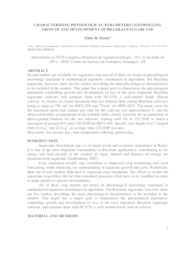Characterizing physiological parameters controlling growth and development of Brazilian sugarcane.
Characterizing physiological parameters controlling growth and development of Brazilian sugarcane.
Author(s): MARIN, F. R.
Summary: Several models are available for sugarcane crop and all of them are based on physiological knowledge translated in mathematical equations coordinated in algorithms. For Brazilian sugarcane, however, there are few studies describing the main physiological characteristics to be included in the models. This paper has a major goal to characterize the physiological parameters controlling growth and development of two of the most important Brazilian sugarcane cultivars, and compare them with NCo376, a well-studied South African cultivar. As results, we found maximum leaf size differed little among Brazilian cultivars, being as large as 796 cm2 for RB72-454 and 733cm2 for SP83-2847. The mean value for the maximum green leaf number per stalk for the cultivars was approximately 9, and the observed biomass accumulation in the millable stalks closely mirrored the accumulation of above-ground biomass for the two cultivars, starting with 9% at 129 DAP to reach a maximum of around 65% after 330 DAP for RB72-454. Specific root length (m g-1) ranged from 16 m g-1 and 22 m g-1 on average from 125 DAP onwards.
Publication year: 2011
Types of publication: Paper in annals and proceedings
Observation
Some of Embrapa's publications are published as ePub files. To read them, use or download one of the following free software options to your computer or mobile device. Android: Google Play Books; IOS: iBooks; Windows and Linux: Calibre.
Access other publications
Access the Agricultural Research Database (BDPA) to consult Embrapa's full library collection and records.
Visit Embrapa Bookstore to purchase books and other publications sold by Embrapa.

